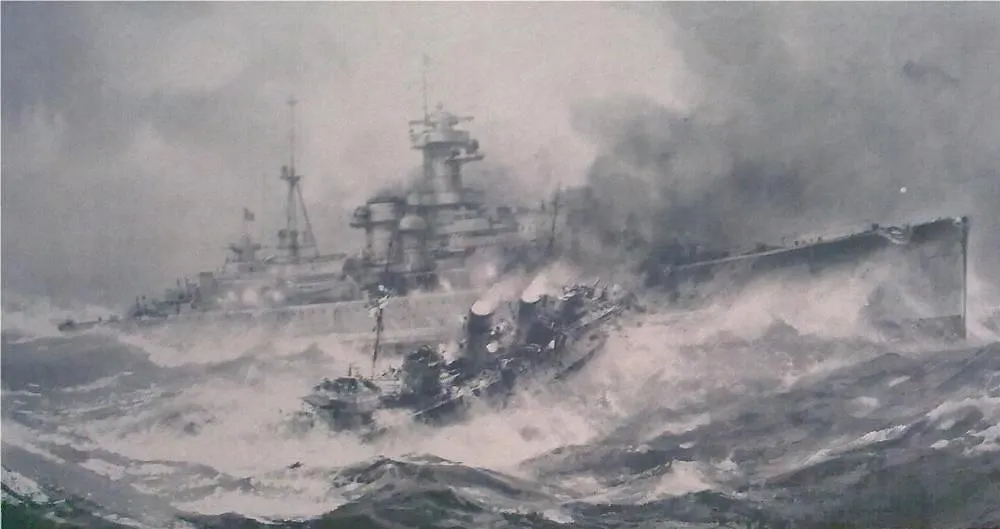

“The lights went out, the ship rolled and tossed and suddenly seemed to settle well on her starboard side,” stoker Bert Harris later said. “The Germans had shot us to pieces. Abandon ship!” HMS Glowworm was lost, but its captain, 35-year-old Lt. Com. Gerard Broadmead Roppe, would win a posthumous Victoria Cross for the action. And, strangest of all, he would get it on the recommendation of the German captain who had sunk his ship.

In April 1940, the Glowworm, a Royal Navy G-class destroyer, was part of the escort for the battle cruiser HMS Renown during mine-laying operations in the North Sea. On the night of April 7, 1940, however, the Glowworm, which was armed with four four-inch guns and ten torpedoes, lost a man overboard in rough weather, and fell behind to search for him.
“That was a bad omen,” Harris later said.
Capt. Roppe eventually had to give up the search and was returning to the Renown when, at about 8:30 a.m., April 8, the Glowworm encountered two German destroyers. The German ships, the Bernd von Arnim and the Hans Ludemann, were escorting the 14,000-ton German heavy cruiser Admiral von Hipper, under the command of Capt. Hellmuth Heye. The cruiser was transferring German troops to Trondheim, Norway, as part of the German invasion.
The Glowworm and the German destroyers exchanged fire, with the Glowworm scoring a hit on one of the two ships before the German ships fled into a squall with the Glowworm in pursuit. But when the Glowworm came out of the squall, she suddenly found herself within range of the Admiral von Hipper and facing that ship’s eight eight-inch guns.

The Hipper opened fire with the Glowworm at 9,200 yards (8,400 meters), and its fourth salvo struck the smaller ship. The Glowworm began making smoke and used the cover to dart back into the squall as the bigger ship continued firing. The Glowworm struggled to get within range of the Hipper. By then, her radio room, bridge, and forward 4.7-inch gun had been destroyed. Her engine room and her rangefinder had been hit, and the small ship was ablaze. The upper yard of her mast had collapsed, falling across wires and short circuiting the ship’s siren that wailed unheeded.

Knowing he had no chance again the Hipper, Capt. Roppe determined to cause as much damage to the larger ship as he could.
Unbelievably, he attacked.
At 10:10, Capt. Roppe fired his ship’s five torpedoes at a range of 870 yards (800 meters), but all five missed their target. Unable to evade the larger ship, he ordered the Glowworm to ram, and the British ship struck the German cruiser near her starboard bow, gouging a large hole in the side of the German ship. The Glowworm scraped along the side of the German ship before pulling clear and coming to rest in the water, flaming and with its siren still wailing.
The Glowworm‘s wheelhouse, transmitting station, wireless office, and the captain’s cabin that was functioning as a first aid station had all been hit and destroyed. There was a huge hole in the side of the ship near the engine room and her superstructure was in shambles.
Capt. Roppe gave the order to abandon ship.

As men were jumping over the side, Harris said, Petty Officer Walter Scott stayed on the only Glowwworm gun that was still operable and “kept that gun going for quite a time.”
In all, 111 members of the Glowworm’s crew were lost, including Capt. Roppe, but with a gallantry that was lost as the war advanced, the Hipper’s Capt. Heye rescued thirty-one survivors of the British ship and congratulated them for the fight they had put up.
“(He) told us that our Captain had been a very brave man,” said Harris.
The Hipper completed her mission, dropping troops at Trondheim, but then returned to port for repairs. She was out of action for a month. From there, Capt. Heye sent a Victoria Cross recommendation for Capt. Roppe to the British War Office.
And Capt. Roppe got it.
